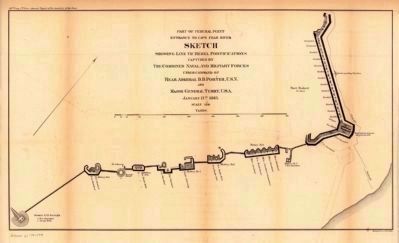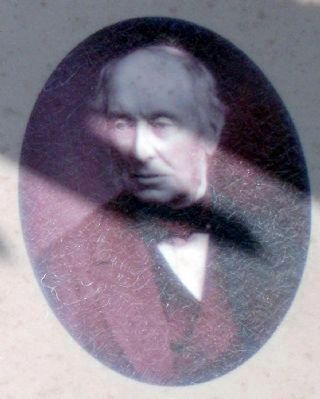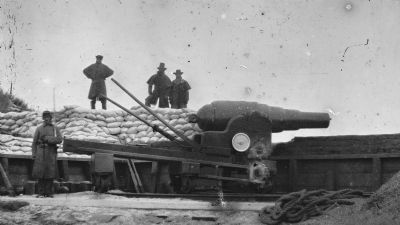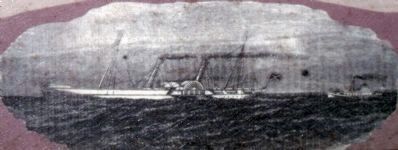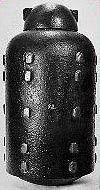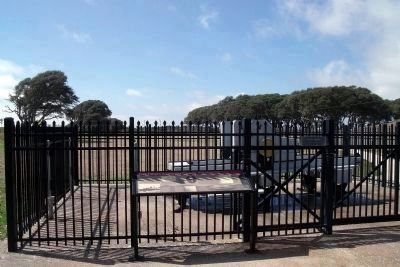Kure Beach in New Hanover County, North Carolina — The American South (South Atlantic)
Fort Fisher’s Armstrong Cannon
The most effective gun in the fort. – Col. William Lamb, Fort Fisher commander
The Confederacy relied heavily on English artillery during the Civil War. A variety of English cannons, including Whitworths and Blakelys, were imported and used at Fort fisher. The most imposing cannon at the fort was the Armstrong 150-pounder mounted at Purdie battery midway along Fisher’s sea face.
Manufactured by Sir William Armstrong & Co. in England, the rifled tube weighed 16,000 pounds and could accurately hurl a 150-pound shell a distance of up to five miles. But even the great Armstrong gun could not prevent the capture of Fort Fisher. In fact, because the Confederates did not have an adequate supply of shells for the gun, it was rarely fired during the final Battle of Fort Fisher in January 1865.
Erected by Fort Fisher State Historic Site.
Topics. This historical marker is listed in these topic lists: Forts and Castles • War, US Civil. A significant historical month for this entry is January 1865.
Location. 33° 58.278′ N, 77° 55.078′ W. Marker is in Kure Beach, North Carolina, in New Hanover County. Marker can be reached from Fort Fisher Boulevard South (U.S. 421) near Battle Acre Road. This marker is located along the quarter-mile tour trail at Fort Fisher State Historic Site. Touch for map. Marker is at or near this postal address: 1610 Fort Fisher Boulevard South, Kure Beach NC 28449, United States of America. Touch for directions.
Other nearby markers. At least 8 other markers are within walking distance of this marker. A Trophy of War (here, next to this marker); Blockade-Running (a few steps from this marker); History Trail (within shouting distance of this marker); Growth of Fort Fisher, 1861-1862 (about 300 feet away, measured in a direct line); Fort Fisher Since 1865 (about 300 feet away); Fort Fisher (about 300 feet away); Lamb Expands the Fort, 1862-1865 (about 300 feet away); Capture! (about 400 feet away). Touch for a list and map of all markers in Kure Beach.
More about this marker. On the upper left is a map of Fort Fisher with the caption, "The Armstrong gun was mounted in Purdie Battery (No. 4) located approximately mid-way along the sea face. After observing artillery practice on December 3, 1864, Colonel Lamb confirmed the gun’s accuracy in his diary entry: “1st shot struck rearmost chimney of Condor; 2nd struck her forward smoke stack; 3rd shot [illegible] struck wreck of blockader.” (Library of Congress)"
On the top center is a portrait of Sir Armstrong with the caption, "In the 1850s England’s Sir William G. Armstrong (1810-1900) produced a line of highly coveted artillery and
projectiles. The British government had such great regard for these weapons that their sale to foreign countries was forbidden until the rearmament of English services was completed in 1862. (British Library)"
On the top right is an inventory report with the caption, "According to Colonel Lamb, prior to the first battle “the Armstrong gun had only one dozen rounds of fixed ammunition.” Forced to save his ordnance, the gun was fired only four times on the second day of the first battle. Confederate reports indicate that one round might have struck the boiler of Admiral Porter’s flagship, the USS Malvern."
On the lower left is a photo of Fort Fisher with the caption, "The Armstrong required a propellant charge of thirty pounds of gunpowder when fired. Local foundries attempted to manufacture two types of bolts (solid shot) for the gun. Southern factories proved incapable of replicating the sophisticated British ordnance. Colonel Lamb described the Confederate-made bolt as “useless.” (Notice the bolts on the floor of the gun pit directly behind the sentry). (National Archives)"
On the bottom center is a report with the caption, "On September 7, 1864, Wilmington district commander Maj. Gen. W.H.C. Whiting notified Richmond of the Hope’s arrival. His successful request for possession of the weapons seems to dispel the myth that they were British “gifts” for Fort Fisher. The guns were divided between New Inlet and Old Inlet, with one gun going to Fort Fisher and the other to Fort Caswell. (UNC Wilmington)"
On the lower right is a drawing with the caption, "On August 24, 1864, the Hope (or Hope of Wilmington), described as being “larger and superior to most [blockade-runners],” left Nassau for her maiden attempt to run the blockade. Among the valuable cargo were two 8-inch, 150-lb. Armstrong cannons. (N.C. Office of Archives and History)"
On the far right is a picture of shell with the caption, "The Armstrong shell stood 16.33 inches tall and weighed 143 pounds, minus the explosive charge. The 8-inch shell featured six spiraling rows of five brass studs to correspond with the grooves in the bore of the rifle. The gun employed shunt rifling. At the muzzle of the cannon the grooves were cut deep on one side and shallow on the other. Gradually the grooves tapered to an equal depth. In loading, the studs of the projectile hugged the deep portion of the grove, but when fired the reverse rotation “shunted” the round to the shallow side, insuring a snug fit and accurate release. (West Point)"
Also see . . . Fort Fisher History. North Carolina Historic Sites entry (Submitted on March 16, 2010, by Bernard Fisher of Richmond, Virginia.)
Credits. This page was last revised on August 21, 2021. It was originally submitted on March 16, 2010, by Bernard Fisher of Richmond, Virginia. This page has been viewed 2,534 times since then and 93 times this year. Photos: 1. submitted on March 16, 2010, by Bernard Fisher of Richmond, Virginia. 2. submitted on March 18, 2010, by Bernard Fisher of Richmond, Virginia. 3, 4, 5, 6. submitted on March 17, 2010, by Bernard Fisher of Richmond, Virginia. 7. submitted on March 16, 2010, by Bernard Fisher of Richmond, Virginia.

